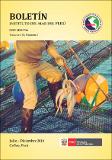Por favor, use este identificador para citar o enlazar este ítem:
https://hdl.handle.net/20.500.12958/3239| Título : | Biología, estructura poblacional y pesquería de pota o calamar gigante (Dosidicus gigas) en el Perú |
| Otros títulos : | Biology, population structure and fishery of jumbo flying squid (Dosidicus gigas) in Peru |
| Autor : | Csirke, Jorge Argüelles Torres, Juan Alegre Norza Sior, Ana Renza Paola Ayón Dejo, Patricia Bouchon Corrales, Marilú Castillo Mendoza, Gladis Castillo Valderrama, Ramiro Cisneros Burga, Rosario Guevara Carrasco, Renato Lau Medrano, Luis Wencheng Mariátegui Rosales, Luis Salazar Céspedes, Carlos Martín Tafur Jiménez, Ricardo Torrejón Magallanes, Edgar Josymar Yamashiro Guinoza, Carmen |
| Director : | Migración |
| Palabras clave : | Dosidicus gigas;Calamar gigante;Distribución |
| Fecha de publicación : | 2018 |
| Editorial : | Instituto del Mar del Perú |
| Citación : | Bol Inst Mar Perú. 33(2) 2018: p. 302-364 |
| Citación : | Boletín IMARPE;33(2), 2018 |
| Resumen : | El calamar gigante (Dosidicus gigas) se encuentra en gran abundancia a lo largo de toda la costa peruana desde 10 hasta más de 500 millas
náuticas de la costa. Realiza migraciones verticales de 0 a 1200 m de profundidad, con migraciones ontogénicas regulares hacia la costa y mar adentro y migraciones latitudinales menos regulares de varios cientos de millas náuticas. Es un predador muy agresivo con un amplio espectro alimentario, y en los últimos 14 años entre
sus presas han predominado cefalópodos (42,33% en peso) y peces mesopelágicos Vinciguerria lucetia (13,05%)
y Myctophidae (12,38%). Diferencias observadas en sus tamaños de madurez sexual, crecimiento y áreas de
distribución sugieren que hay al menos tres grupos fenotípicos o subunidades poblacionales frente al Perú. La
distribución de frecuencia de tallas en las capturas de flotas artesanales e industriales en aguas peruanas ha
sido muy variable, con un cambio significativo a tallas mucho más grandes que se inicia el año 2000 y se hace
más evidente a partir del año 2001. Desde entonces, los calamares capturados en aguas peruanas han sido por
lo general bastante más grandes que los capturados en la alta mar adyacente. La pesquería peruana de calamar
se desarrolló rápidamente a principios de la década de los años 1990, con aumentos en las capturas por una
flota potera industrial extranjera operando bajo licencia peruana y una pesquería artesanal local en rápida
expansión, que sustituyó gradualmente a la pesquería industrial. Las capturas totales de calamar gigante de
Perú alcanzaron un máximo de 556 mil toneladas en 2014, todas capturadas por flotas artesanales locales.
El stock, o stocks, de calamar gigante en aguas peruanas se consideran sub-explotado o moderadamente
explotado, y las evaluaciones se basan en estimaciones de biomasa de cruceros acústicos combinados con
modelos de producción excedente. Se discute la idoneidad de estos y otros métodos de evaluación de stocks,
dando particular atención a la estructura de la población, la presencia de tres grupos fenotípicos o posibles
subunidades poblacionales, así como otras características observadas en el calamar gigante frente a Perú y sus
implicancias para la evaluación y ordenación de su pesquería. Jumbo flying squid (Dosidicus gigas) is found in high abundance along the whole Peruvian coast from 10 to more than 500 nautical miles from the coast. It performs diel vertical migrations from 0 to more than 650 m of depth, with regular inshore-offshore ontogenetic migrations and less regular latitudinal migrations of several hundred nautical miles. It is a very aggressive predator, having a wide food spectrum with predominance, in the last 14 years, of cephalopods (42.33%, by weight) and the mesopelagic fishes Vinciguerria lucetia (13.05%) and Myctophidae (12.38%). Observed differences in their size at sexual maturity, growth and distribution areas suggests that there are at least three phenotypic groups or population subunits off Peru. Their size frequency distribution in catches by both artisanal and industrial fleets in Peruvian waters has been highly variable, with a significant shift to much larger sizes that started in 2000 and became evident in 2001. Since then, squids caught in Peruvian waters have generally been much larger than those caught in the adjacent high seas. The Peruvian squid fishery developed rapidly during the early 1990s with increased catches by a licensed foreign industrial jigger fleet and a rapidly expanding local artisanal fishery that gradually phased out the industrial fishery. Total Peruvian catches of jumbo flying squid peaked at 556 thousand tons in 2014, all taken by local artisanal fleets. The stock or stocks of jumbo flying squid in Peruvian waters are considered to be underexploited or moderately exploited, and the assessments are based on biomass estimates from acoustic surveys combined with surplus production modelling. The suitability of these and other stock assessment methods is discussed giving particular attention to the observed population structure, the presence of three phenotypic groups or possible stock subunits, as well as other characteristics of jumbo flying squid off Peru and what they may imply for the assessment and management of this fishery. |
| URI : | https://hdl.handle.net/20.500.12958/3239 |
| ISSN : | 03787702 |
| Aparece en las colecciones: | Boletín 33(2), 2018 |
Ficheros en este ítem:
| Fichero | Descripción | Tamaño | Formato | |
|---|---|---|---|---|
| Boletin 33(2)12.pdf | Biología, estructura poblacional .. | 2,43 MB | Adobe PDF |  Visualizar/Abrir |
Este ítem está sujeto a una licencia Creative Commons Licencia Creative Commons

